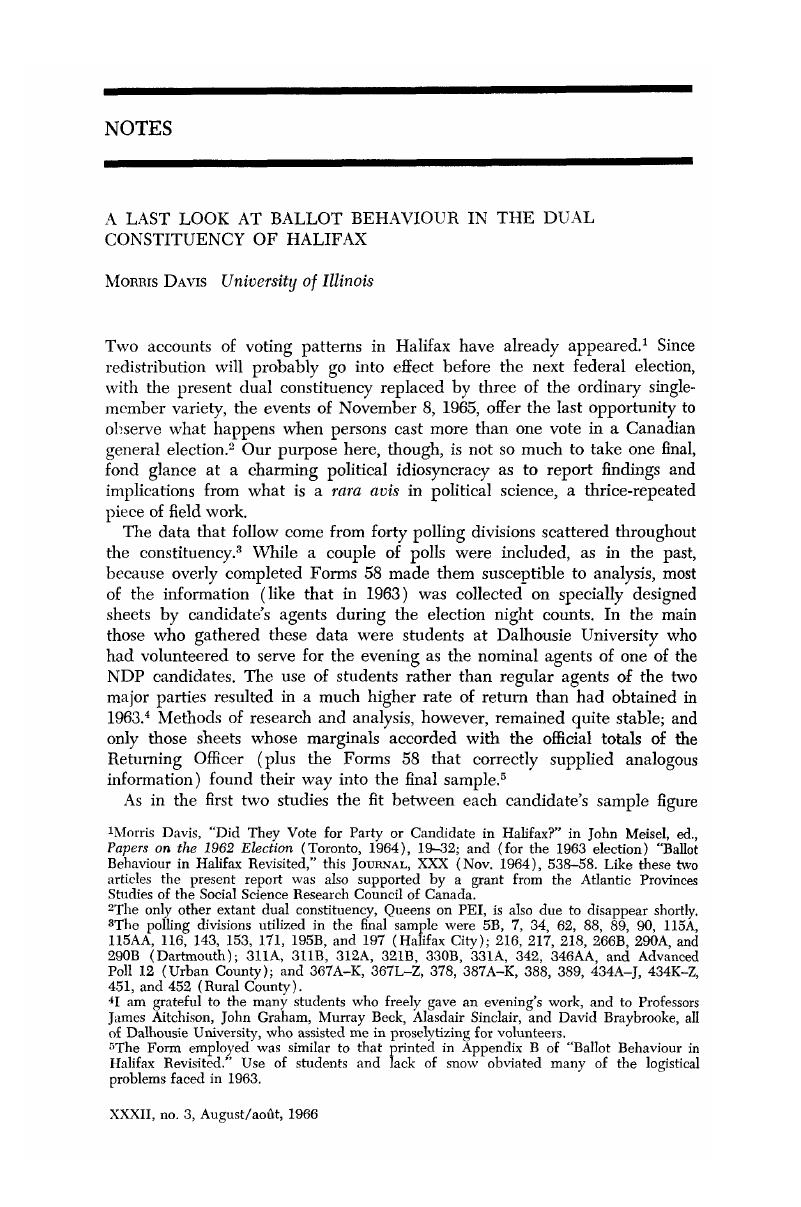Article contents
A Last Look at Ballot Behaviour in the Dual Constituency of Halifax
Published online by Cambridge University Press: 07 November 2014
Abstract

- Type
- Notes
- Information
- Canadian Journal of Economics and Political Science/Revue canadienne de economiques et science politique , Volume 32 , Issue 3 , August 1966 , pp. 366 - 371
- Copyright
- Copyright © Canadian Political Science Association 1966
References
1 Davis, Morris, “Did They Vote for Party or Candidate in Halifax?” in Meisel, John, ed., Papers on the 1962 Election (Toronto, 1964), 19–32 Google Scholar; and (for the 1963 election) “Ballot Behaviour in Halifax Revisited,” this Journal, XXX (11 1964), 538-58.Google Scholar Like these two articles the present report was also supported by a grant from the Atlantic Provinces Studies of the Social Science Research Council of Canada.
2 The only other extant dual constituency, Queens on PEI, is also due to disappear shortly.
3 The polling divisions utilized in the final sample were 5B, 7, 34, 62, 88, 89, 90, 115A, 115AA, 116, 143, 153, 171, 195B, and 197 (Halifax City); 216, 217, 218, 266B, 290A, and 290B (Dartmouth); 311A, 311B, 312A, 321B, 330B, 331A, 342, 346AA, and Advanced Poll 12 (Urban County); and 367A–K, 367L–Z, 378, 387A–K, 388, 389, 434A–J, 434K–Z, 451, and 452 (Rural County).
4 I am grateful to the many students who freely gave an evening's work, and to Professors James Aitchison, John Graham, Murray Beck, Alasdair Sinclair, and David Braybrooke, all of Dalhousie University, who assisted me in proselytizing for volunteers.
5 The Form employed was similar to that printed in Appendix B of “Ballot Behaviour in Halifax Revisited.” Use of students and lack of snow obviated many of the logistical problems faced in 1963.
6 Some 0.3 per cent of the voters cast rejected ballots. The total (99.9 per cent) differs from 100.0 per cent because of rounding.
7 Votes for Kennedy are consistently omitted from Tables II and III. Their inclusion would affect the figures only slightly, and the rank orders not at all. Table I corresponds to Table V in the earlier articles; Table II to Tables VI, VII, and VIII; Table III to Table IX; and Table IV to Table XV (in the second article only).
8 Cf. the discussion of Edmun d Morris in “Did They Vote for Party or Candidate in Halifax?” 29–31.
9 Aitchison's remarkable attractiveness as a candidate, reflected in his very high figures for columns 1 an d 2 and his very low score on column 3, closely conforms to his showing in the 1962 election, when he last ran. Ibid.
10 Some thirteen electors who cast plumper ballots were encountered during interviews conducted in Halifax in the week following the election. While six of these persons stated (in answer to an open-ended question) that their plumper ballots were candidate-inspired, five claimed that they voted as they did for party reasons. (The other two cited ideological and familial considerations.) Furthermore, all thirteen were able correctly to identify the party affiliation of the candidate they supported. For these data I am grateful to Professor Braybrooke.
11 See Ward, Norman, “Voting in Two-Member Constituencies,” Public Affairs, IX (09 1946), 220-3.Google Scholar The rationale and the limitations of this approach are discussed in both earlier articles.
12 The error is so small, though, that computing the figure for all the polling divisions scarcely seemed worth the effort. In addition, the figures in row 2 of the earlier Table XV had been based on samples.
13 Split and plumper ballots for the Liberals totaled 208 (Butler) and 323 (Lloyd); and for the NDP, 158 (Aitchison) and 94 (Wallace).
14 Thus, for example, the high figure of 3.51 for the Liberals in row 5.
15 “Ballot Behaviour in Halifax Revisited,” 550.
16 Ibid., 551.
- 1
- Cited by




